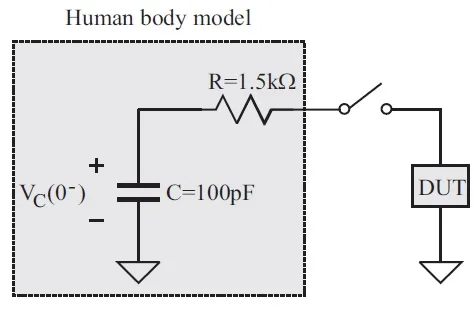ESD models,classes,protection basics | ESD Human Body Model
This page on ESD (Electrostatic Discharge) describes ESD classes, ESD models, ESD protection mechanism,ESD human Body model and ESD test equipment manufacturers.
When two surfaces which are in contact get separated, some atom electrons will move. This causes imbalance. Here one surface has positive charge and the other has negative charge. Examples of ESD: Lighting, zap from a door
In general, ESD is the transfer of electrostatic charge between bodies (or between surfaces) at different electrostatic potential.

Following table-1 mentions examples where in large charges are generated at all the time. People discharge frequently, but to feel it must be about 3000 volts. ESD which a person can not feel will damage the electronic components very easily. The voltage about 100 volts or less can damage the components. Smaller components mean greater sensitivity to ESD. Damage to these components can not be detected by the naked eye.
| Charges generated due to | Voltage level |
|---|---|
| Walking across a carpet | 1,500 - 35,000 volts |
| Walking over untreated vinyl floor | 250 - 12,000 volts |
| Vinyl envelope used for work instructions | 600 - 7,000 volts |
| Worker at a bench | 700 - 6,000 volts |
| Unwinding regular tape | 9,000 - 15,000 volts |
Table-1 Typical Voltage Levels of Charges Generated
Like we have adopted methods to control germs in medicine, we need to adopt and use various ESD protection devices/methods to control ESD(Electrostatic Discharge). Following table mentions ESD classes with sensitivity levels and various electronic components affected by them.
ESD Classes
Following table mentions various classes of ESD which include ESD class 0, class 1, class 2 and class 3A.
| ESD Class | Sensitivity | Device names |
|---|---|---|
| ESD Class 0 | <250 Volts | SAW, JFETS, CCDs, Precision voltage regulator diodes, OP AMP, Thin film resistors, Integrated circuits, Hybrids utilizing class 1 parts, VHSI, CSCRs |
| ESD Class 1 | 250 to 1999 volts | -Same as above- |
| ESD Class 2 | 2000 to 3999 volts | JFETs, ICs, VHSIC, Precision resistor networks (type RZ), Hybrids utilizing class 2 parts, Low power bipolar transistors |
| ESD Class 3A | 4000 to 7999 volts | JFETs, OP AMPS, ICs, VHSIC, All other microcircuits not included in class 1 or class 2, Small signal diodes, General purpose silicon rectifiers, Opto-electronic devices (LEDs, phototransformers, opto couplers), Resistor chips, Piezo electric crystals, Hybrids using Class 3 parts |
Table-2 ESD Class
Principle sources of ESD in ICs
Following are the principle ESD sources commonly found.
• A person walking on synthetic floor can accumulate about 20Kvolts.
This is discharged when he/she touches anobject which is at ground potential.
• Equipment accumulate static charge due to improper grounding.
The charge gets through ICs when it is placed on test sockets.
• ICs themselves get charged during transport and when they come in contact with charged objects.
ESD Human Body Model, Machine Model, Charge Device Model
Following are the various ESD models which include ESD human body model, ESD machine model and ESD charge device model.

Figure-2 depicts ESD of a Human Body referred as ESD Human Body Model.
Peak current is about 1.3A, rise time is between about 10 to 30 ns.

Figure-3 depicts ESD of a Machine referred as Machine Model(MM).
Peak current is about 3.7A, rise time is about 15 to 30 ns and Bandwidth is about 12 MHz.

Figure-4 depicts ESD of a Charged Device referred as Charge Device Model (CDM).
Peak Current is about 10A, Rise time is about 1 ns.
ESD protection mechanism
Following are the various ESD protection mechanism commonly used.
• ESD protection circuits as mentioned for different model
• Current Limiting Characteristics of n-well Resistors
• Avalanche Multiplication in pn-junctions
• Avalanche Breakdown of nMOS
• Thermal Breakdown of nMOS
ESD Protection Devices
Following are the list of ESD protection devices.
• n-well Resistors
• Gate-Grounded nMOS Transistors (GGNMOS)
• Gate-Coupled nMOS Transistors (GCNMOS)
• Silicon Controlled Rectifiers (SCR)
• Medium Voltage Triggered SCR
ESD test equipment manufacturers
Following is the list of ESD test equipment manufacturers.
• Advanced Test Equipment Corp. (https://www.atecorp.com/) {ESD Gun, ESD Simulator}
• Thermo Fisher Scientific Inc. (https://www.thermoscientific.com/) {ESD Tester}
• TREK, INC (https://www.trekinc.com/), (ESD Audit Equipment, ESD Test Equipment}
• HV TECHNOLOGIES, Inc. (https://www.hvtechnologies.com/)
• United Static Control Products (https://www.ultrastatinc.com/)
• ESD testers and Meters (https://www.esdmeters.com/)
• Botron Company Inc. (https://www.botron.com/) {ESD table mat, floor mat, equipments, wrist straps, gloves, chairs etc.}
Test and Measurement Equipments
Test and Measurement Equipments BER Testing equipments Agilent T & M Solutions Anritsu T & M Solutions Rohde & Schwarz T & M solutions wireless channel emulator Vector signal generator Vector signal analyzer Power Analyzer Equipments Protocol Analyzer
